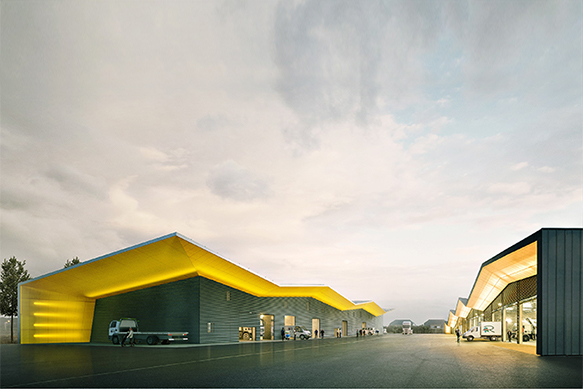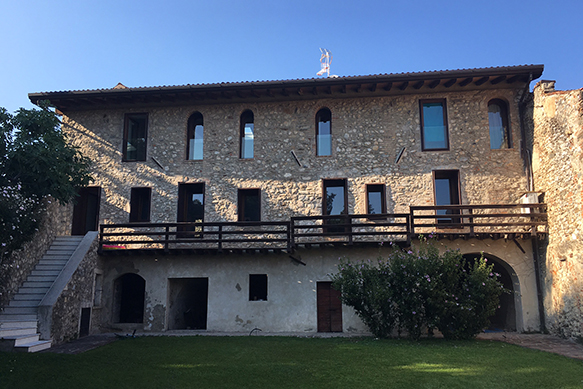 ARCHITECTURE
ARCHITECTURE

 ARCHITECTURE
ARCHITECTURE
MFA is an architectural office involved in architecture, urban and landscape design both in private and public sectors. The acquired experience through several years in France, Belgium and Italy enabled to gain a high-level practice, in which architectural research plays a leading role. MFA lays the foundations for an architecture whose project development becomes an opportunity for research and deep experimentation. In each architecture, urban planning and landscape design, the main purpose is to perceive and conceive the context, as a place looking for its own identity, in order to reveal its own nature and geography. The aim is to reach a smart and dynamic architecture, to be included in the “landscape living organism”, both urban and rural, in order to get the best representation of nature or city. This approach compels to investigate the context, and allows a plain integration in the landscape geography avoiding barren practices. Our inclination is to return architecture a more human impact, to enter at best in present and future reality. Beyond real and planning matters, it is essential to give back projects a poetic dimension: the hard craft is to give architecture a soul.


The project is set up as an opportunity to bond what has been artificially divided in the city of Teramo, starting from the peculiarities of the existing environmental system: in opposition to the existing serial-functionalist scheme, the project is parallel to the curves of the soil, interpreting them as an element of continuity which integrates different levels of intervention, through both a logic of “grip” of the building and respecting the construction phases required. The broken line generates a double front, north-south, which enhances the relationship with the landscape, opening up towards the valley and the old city, thanks to all the living spaces positioned towards south, and a greater connection with the park onto which all bedrooms of the various apartments face.









The project assumes pedagogical principles to define the new challenges arising from care needs (elderly day centre) and from updated regulations (seismicity): the complex is divided into blocks linked by a central square and safe walking routes that can be used by several users and at different times of the day. A spatial distribution that meets the demands of contemporary education, with great flexibility and internal transparencies is developed. At the same time, the possibility to use the school spaces for multiple scopes is ensured. The project considers the inclusion, in addition to the school building, of a library, a media centre, a gym, a garage, and the aforementioned elderly day centre. With Architect Camillo Botticini.







The building intercepts paths of the park “The Library of Trees”, assuming them as elements generators of the project. Duplicity, of being object and subject at the same time, emphasizes itself for its condition of sculptural mass excavated, highlighting the character of public building, of abstract and silent element, able to release energy: it is with a central space with double height that the dynamic between attraction / projection is resolved, placing various functions both at the ground floor and at first floor, referring to the archetype of the fence as a general principle. As in a Lombard Broletto, the central space is protagonist, a place of encounter and exchange for the community. With Architect Camillo Botticini and ing. Alessandro Gasparini.







The project proposal summarizes three basic components of an architecture (not just residential) in a real prototype intended as an element that fixing some rigid elements is open to multiple interpretations project, being individuated as a solution that consistently precisely in relation to the construction system: content technological and constructive aspects typological distribution, settlement size, architectural quality. Flexibility is the foundation of this proposal in all its specificity: construction flexibility, typological flexibility internal and external to the housing proposal. With Architect Camillo Botticini.















The project aims to achieve a balance between its representative character and its willingness to integrate into the landscape, searching out its essence in the relationship between primary structures, without abandoning the conceptual and spatial dimension of the constructive archetype. The "wall", intended as a memory of ancient signs of the Irish landscapes, recalls the traditions of dry-stone walls, and generates a new public space. The fence, as a basic element enclosing open spaces, is a sign connected to the idea of wall. The presence of these barriers, of these boundaries, blocks the view towards the surroundings but it allows the creation of confined and controlled spaces. The depression of these spaces allows to maintain these safe areas but gives back wide views towards the landscape. These few basic signs are a depiction of the charm of the site imagined as a background for the new school complex. The required volume with its proper orientation and patios will create an ideal project of a school that can be repeated again and again. Conceived as an element with its own identity, a blunt and sleek volume containing most of the functions that can be used by the community, stands out clearly. From this volume, at a lower level, classrooms and their patios open towards the surrounding landscape.












Established in 1924, the brand Umbro is one of the most famous in the sportewear field. An entire floor of the italian headquarters is dedicated to the administration, sales offices and boardrooms. The aim is to ease communication between employees and permit a direct vision towards the city. In this regard, a curved launch window works as a filter between the city and the working space. At this level the terrace is set as a small soccer field to recall a real and playful ambience. The upper floor is used as a showroom to display any kind of Umbro's products.The willing is to set up a flexible space that is strongly recognizable and deeply characterized. Black, white and green as grass fields are the only colors used.The showroom is an open space in which mobile walls can rotate 90 degrees and create 8 different configurations of disposal to exhibit various apparel collections, one of these is the meeting and events' configuration, in which any piece of furniture can become a comfortable seat. The overall aim is to create spaces of high quality that stand for a world famous brand.


































The aim is to respond to the potential change in this former industrial area. The basic idea is to create a variety of attractive environments that can offer a high quality of life. The area will provide protected, green and recreational spaces as well as a connection to the city. A new green corridor, a spine, through the site will give people access to all new places. The project is permeable and flexible, its architecture acts as a diaphragm between city and park. Green courtyards, raised squares, terraces and verdant semi-private spaces protected from noise and chaos come to life to give users a better perception of their surrounding space, with different horizons and new visions of the city and the park itself.

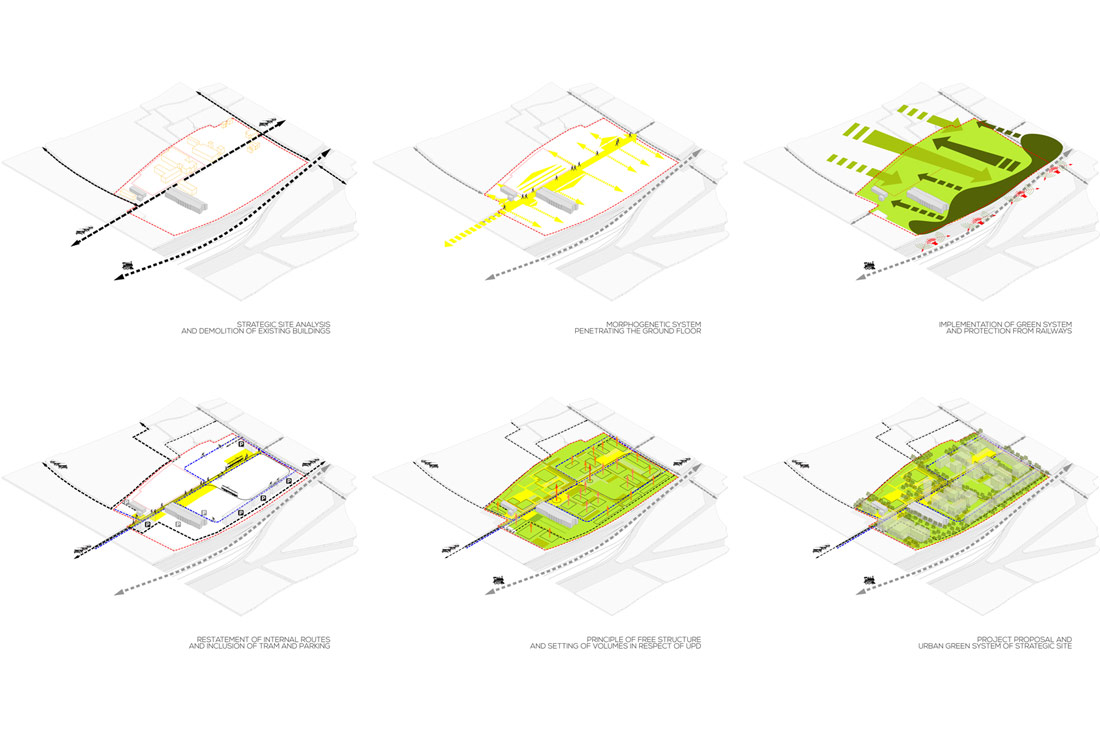

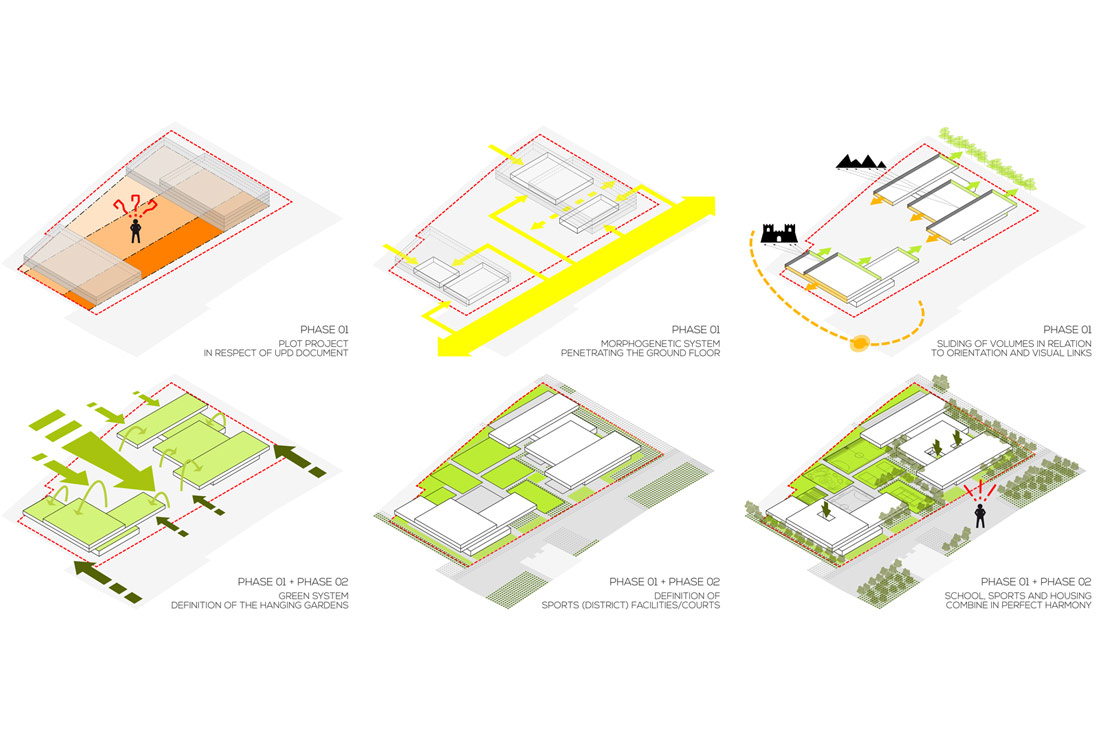

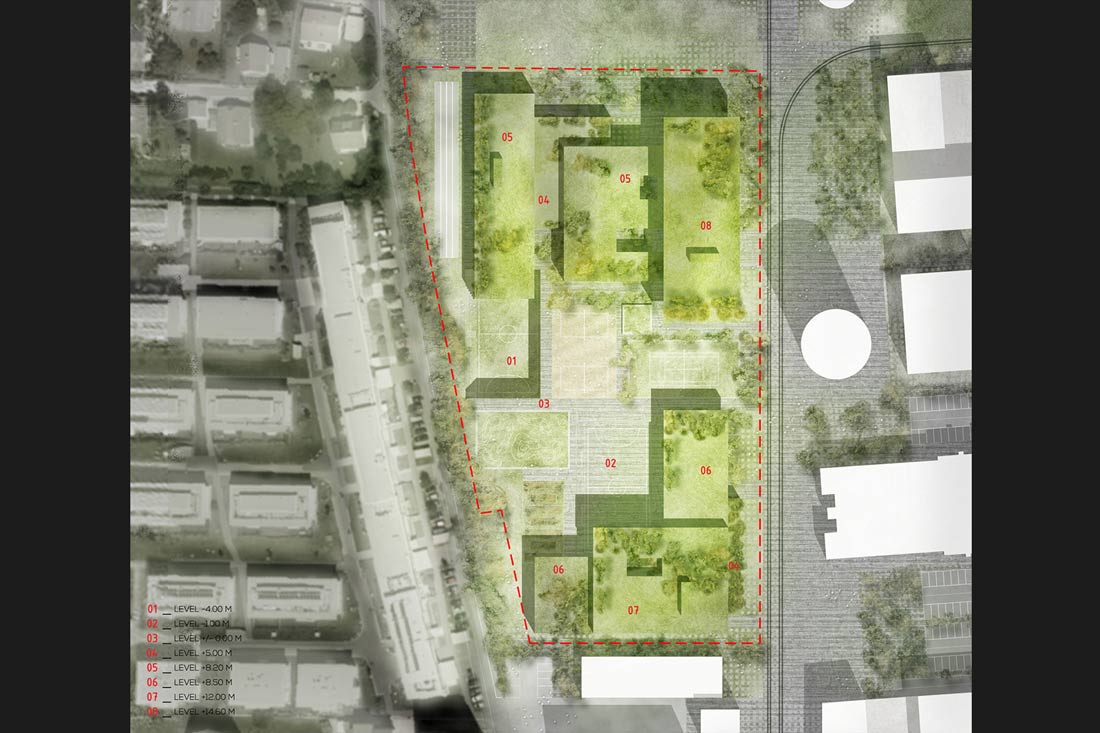

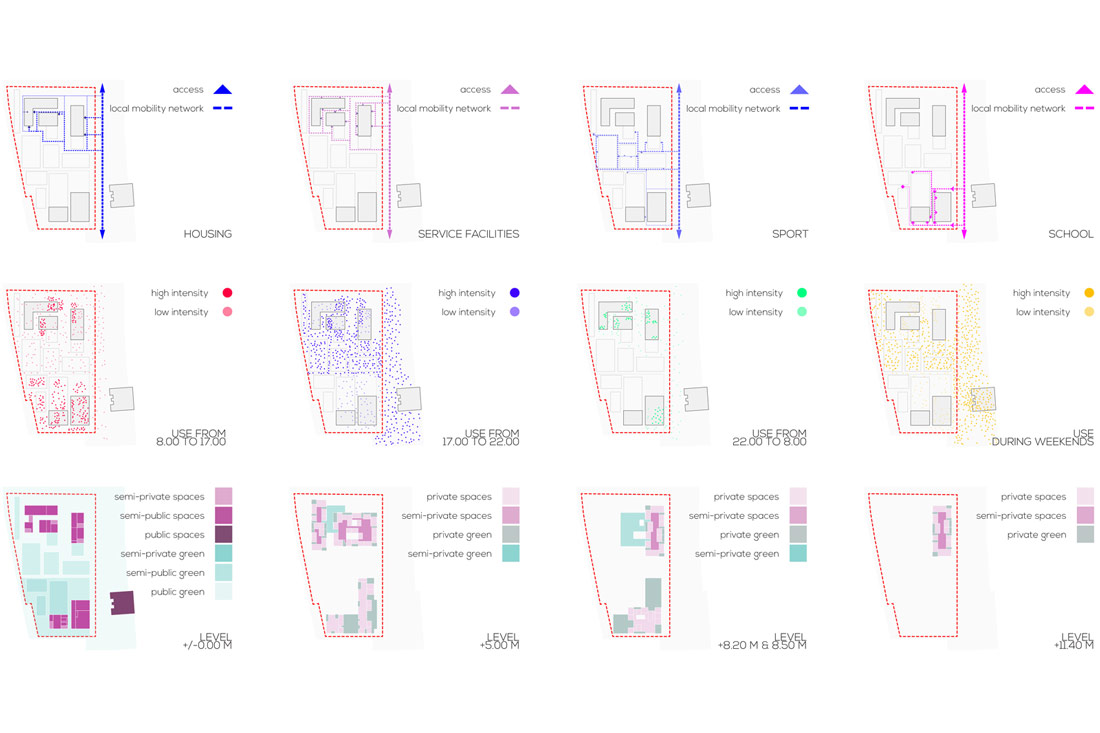
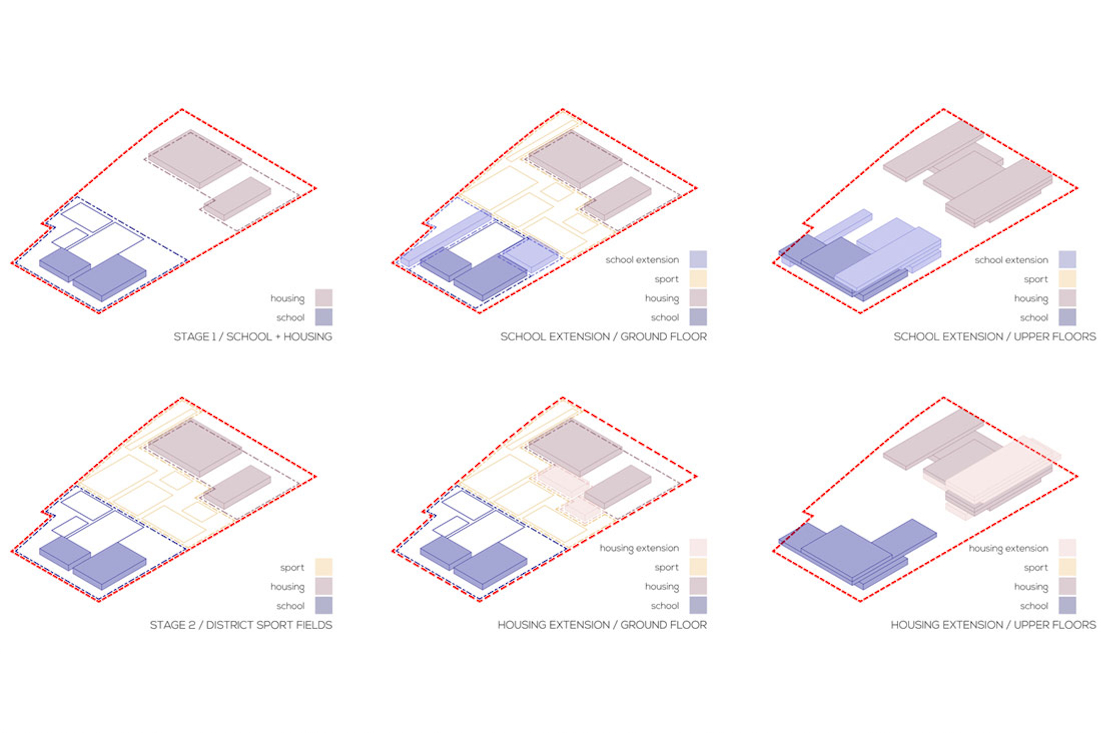

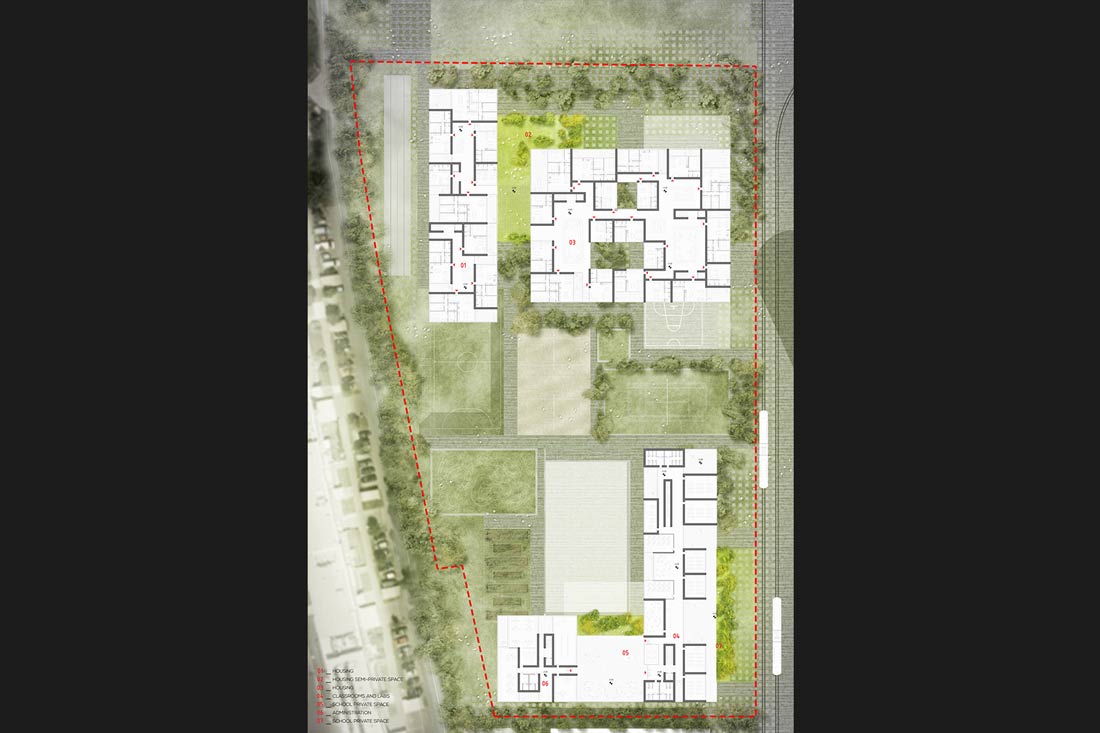
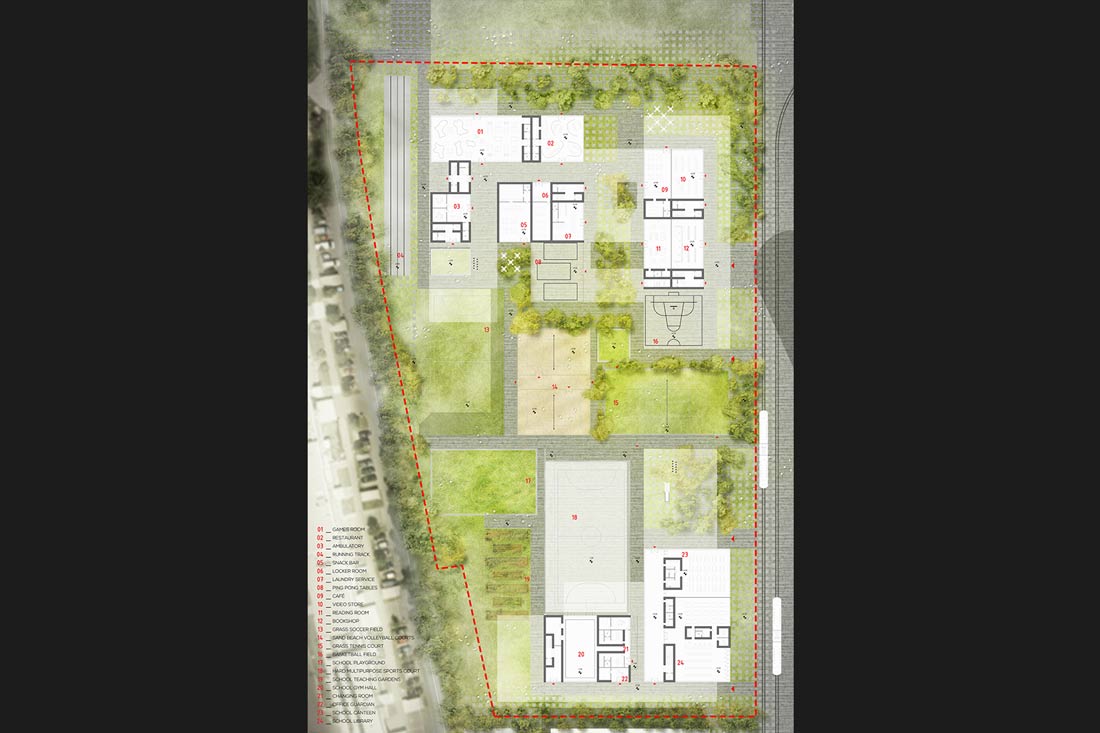
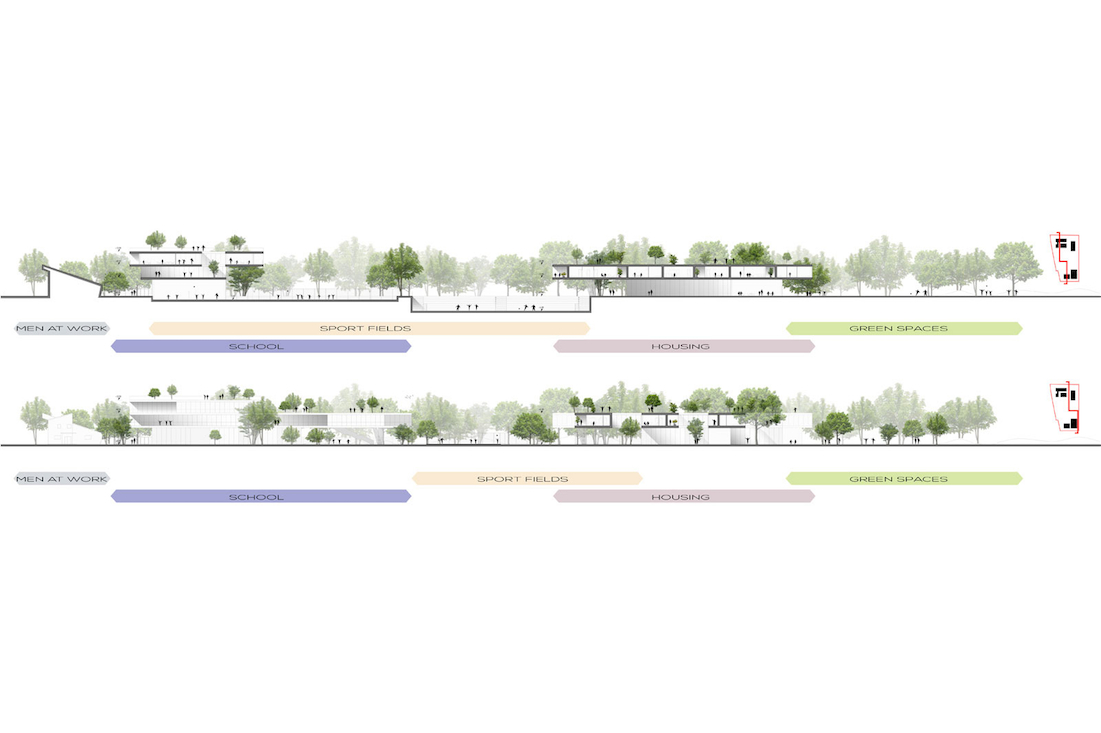



Where the technical problem is overcome, architecture begins" (L. Mies Van der Rohe)
A rural context and in opposition a big residential area suggested an impressive architecture, well-integrated into the surrounding landscape. The volumetric model was inspired by the Alsatian architecture's archetype, which repeated, permits to get a variable volume, suitable for a public building. Therefore the most remarkable sign is the roof that unifies all the functions under an unique architectural element. Peculiarities of site, suggested us to design a sole building. The concentration of the first phase functions in one place will permit notable economic savings and will facilitate building's management and maintenance. The proportion of the building defines a strong but simple architecture, a building that even though can be defined industrial still keeps familiar thanks to the reference of pitched roofs.
With Nicola Martinoli Architect



















The project tries to achieve a balance between its representative character and its willing to integrate into the landscape, searching its essence in the relationship between primary structures without abandoning the conceptual and spatial dimension of the constructive archetype. The wall, intended as a memory of the ancient signs that represent agricultural landscapes, generates a new public space, highlighting the idea of transformation. The base is to strengthen the primal meaning of connection to the floor of the building, underlining the relationship of the winery with the surrounding landscape. Conceived as an element with its own identity, the base reveals another level, from whose background new and existing stand out. The structure of the building turns out to be capable of delineate the presence and mission of the winery and its iconographic impact, although related to the environment, makes the building an identifiable mark in the territory. The structure itself causes a soft distinction between the productive activities of the winery and the flow of visitors. For both functions in fact, it creates a defined space but not totally separate from the rest: a space throbbing with activities related to the knowledge of wine tasting, to its scientific and convivial insights. Thus a new level is established, hosting all public functions, welcome point, showroom, degustation area and guest rooms.

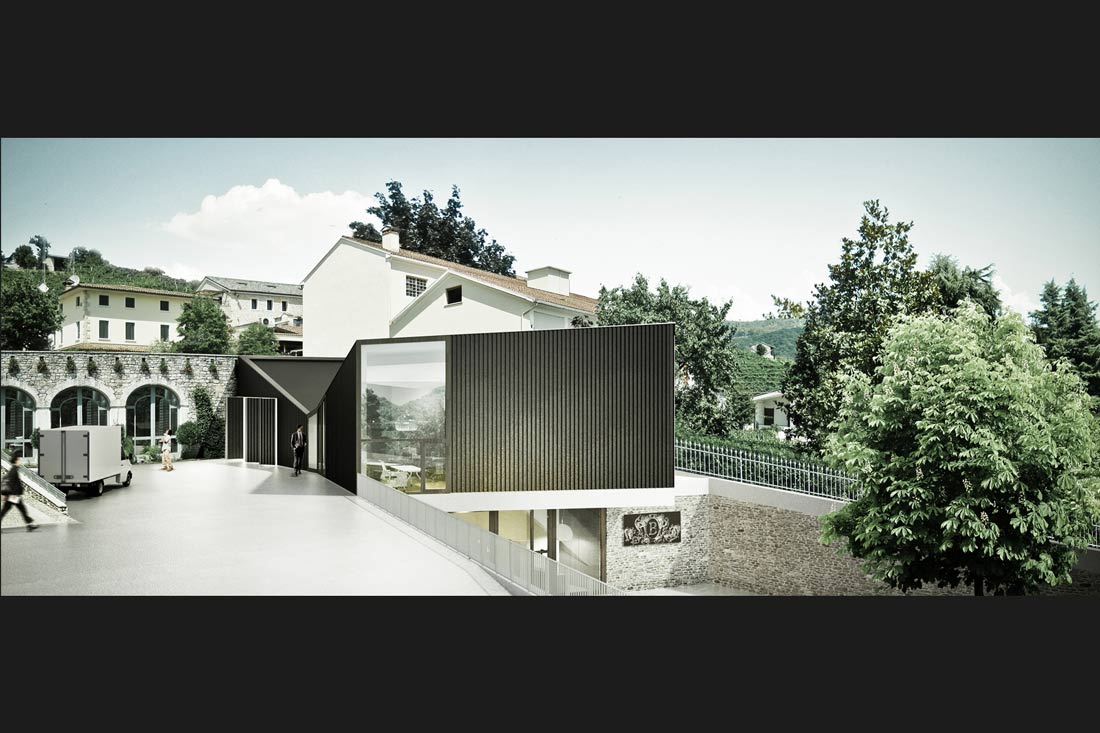
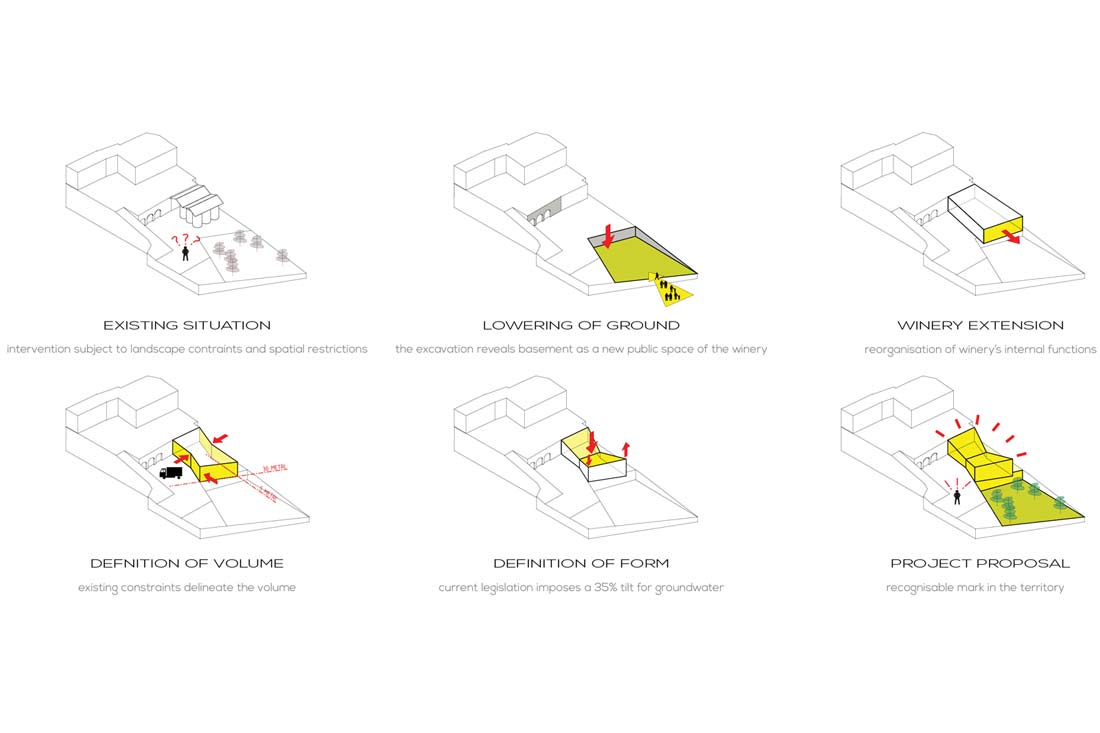
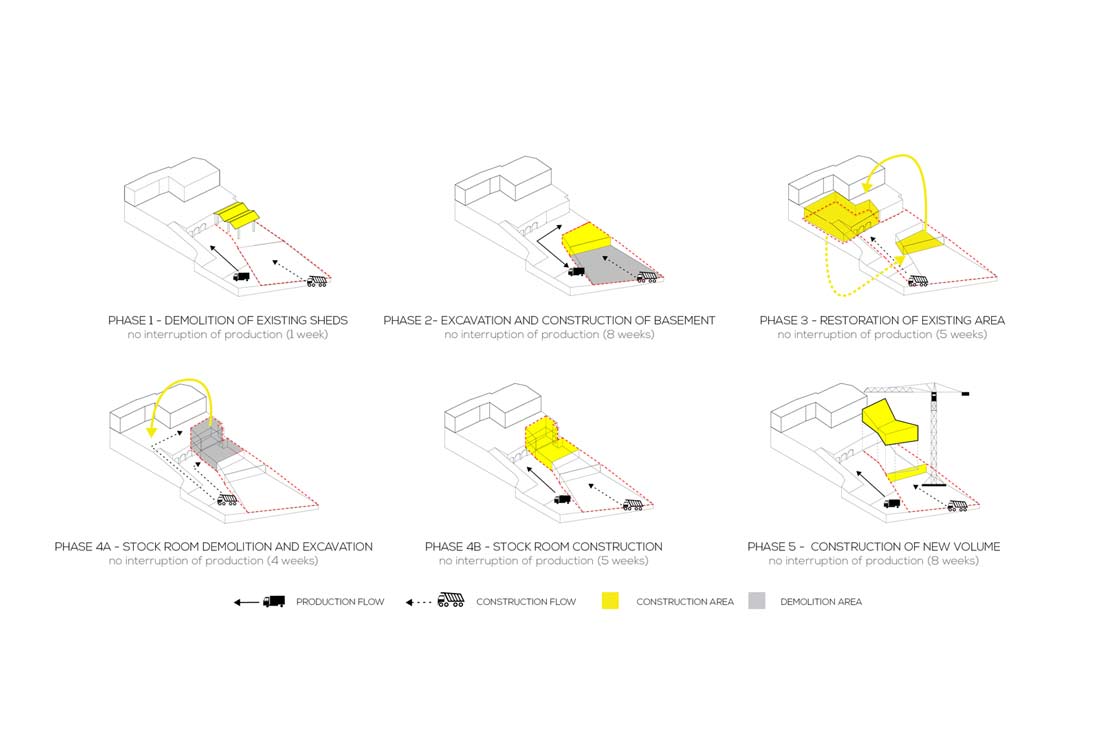






















The idea of a sheltered promenade, that directs clients and managers from their offices to the production of transfer machines, has as its own principle, the relationship between the company and the productive aspect to stimulate a constant and continuous bond between the development of products and the control of the final outcome. The project is sited between the administrative building and the green outside spaces. The link is simple and creates a shelter, it is a threshold between green space and ironstone, between nature and artifice. Its technological features try to relate to the existing context, details are studied to obtain the best construction. The matt black finish of the structure follows both aesthetic and functional logic proper to the company. The light structure floats among trees, changing its appearance depending on the weather, it blends with the natural and industrial context that surrounds the site.

















The sport park is a fluid, natural and continuous space in which users can easily reach the several sports attractions installed in the area. Hybrid spaces and a powerful mix of urban and innovative sports, draw from the world of young people to become future reality. If usually architecture segments and closes spaces, here architectures open towards the context and suggest new interpretations about its landscape. Architectures change aspect to create new spaces that serve sports activities. The various slopes in the park offer observers unexpected points of view and many different entrances to buildings. Apparently in contrast with the abstract design of the entire park, synergy with surrounding landscape has being achieved thanks to the fluid and harmonic geometry that becomes an integral part of the Sport park. A new and dynamic space gives the city new qualities and revitalizes a former industrial area.

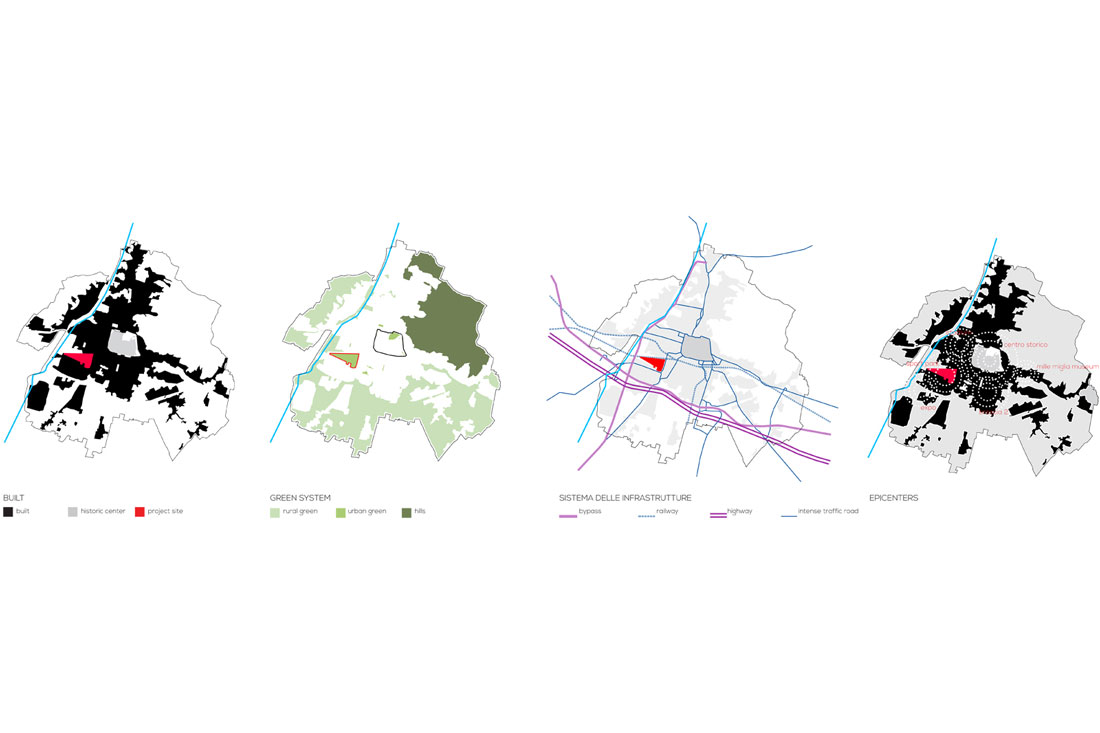














The starting point for the project of a school complex is the right relation between the built and the open space. The relation between the mountain environment and the site for the new school is astonishing. The primary school is situated in the southern part, directly linked to the canteeen (west), the gym (east) and the kindergarten (north-west). The new volumes settle following a comb-scheme that allows the best energetic placement possible. This scheme following the east-west direction seems to be very useful for the technological system occurring the school complex, placed in the walls and floors of the building. The new volumes are parts of an occupied landscape, and the pavilion morphological choice aims to determine a way for light and air beteen the buildings, the open spaces and the context.
With Paolo Mestriner Architect


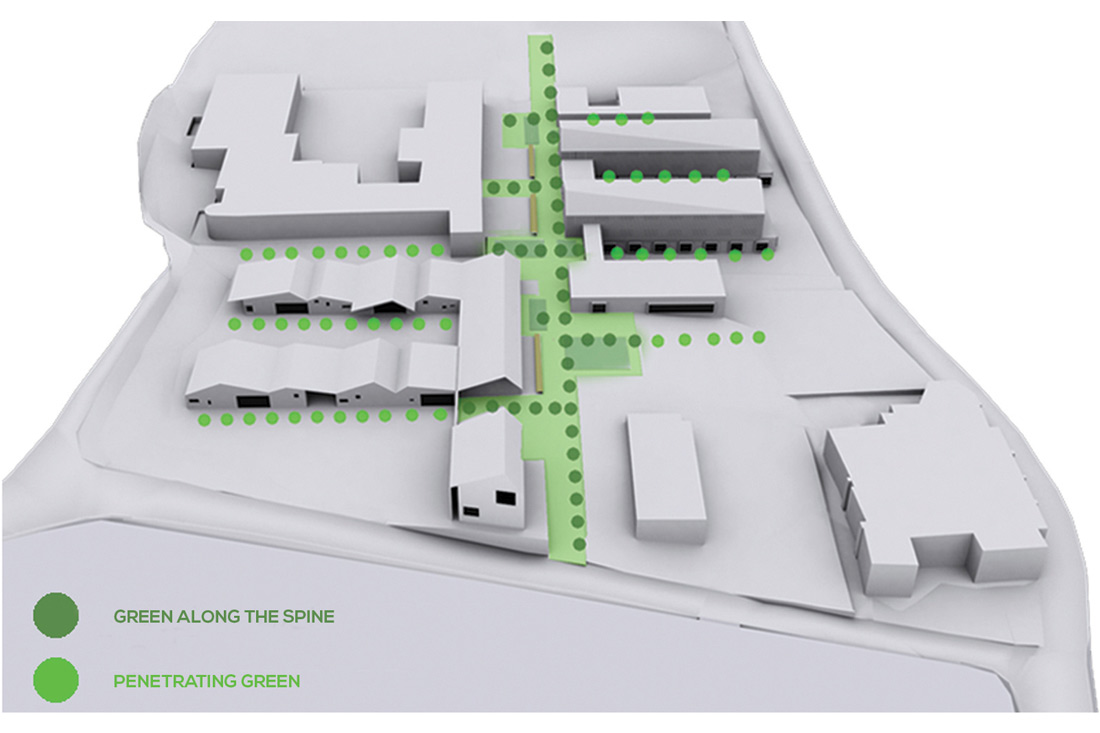








The pretext of an intervention often changes the way of living a space and it emphasizes his value. The space is interpreted with a new aim, changing his aspect but not his function. The canteen hall remains a container for a break, a stop, a meal. The function of daily meal becomes place of share and exchange. The new appearance of the canteen represents a different faceting for a certainly gain-orientated company, but conscious of increasing the quality level of the working environment to increase in the employer the sense of belonging, to give back efficiency and loyalty. The environment gets back his distinguishing character, his proportion in a new disposition. The functional layout rises from an internal fluxes study, allowing a better spaces displacement, in order to better live the canteen in the different lunch times. In particular, the private hall is reserved for managers and clients, and the rest of the hall to machine workers.





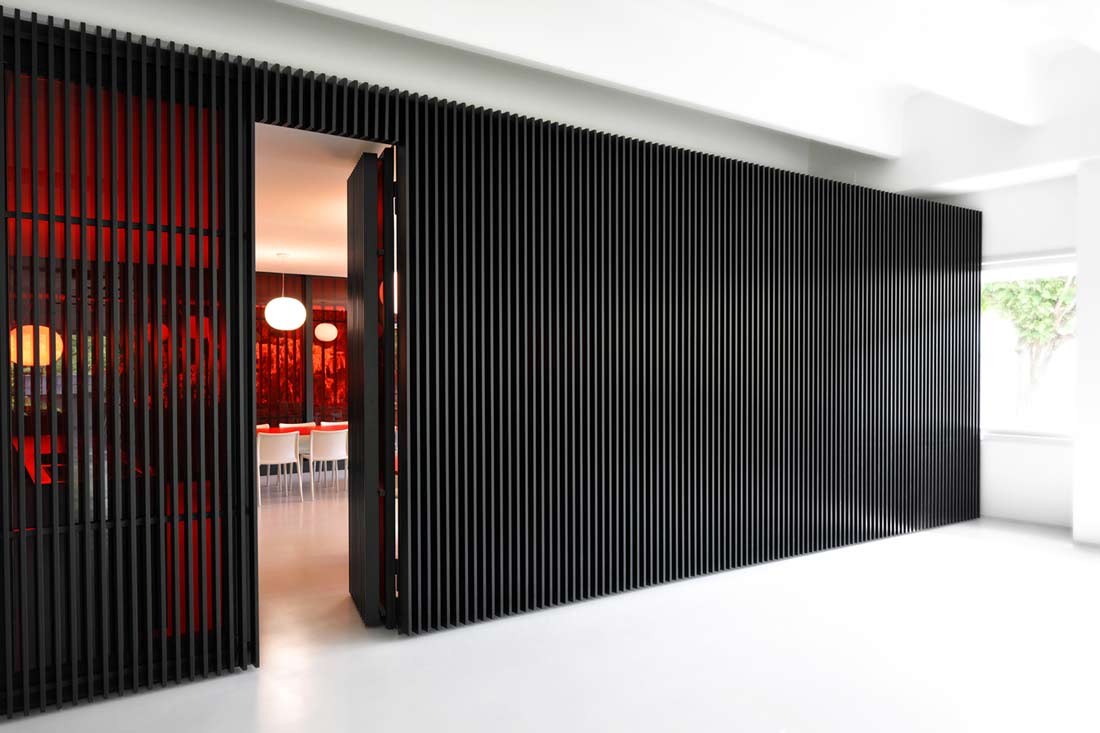







This project represents the change potential in progress in our society: from the lifestyle to the relationship between persons, all is to be rediscovered and reinvented; our mission is to offer a fertile soil for experimentation, and for the concretization of the changes of our time too. Different environments, new and protected spaces result more attractive and give better quality of life: an open-to-green side with a recreational vocation, and another one to the city and to the people to whom the crossing of the entire area is guaranteed. A flexible and permeable project defines the architecture as a barrier between city and park: it gives life to high squares or hanging gardens, semi-private spaces preserved from noise and chaos, allowing his users a better perception of the space, with different horizons and new overviews on the city and the park. The buildings interact with inhabitants needs and lifestyles: architecture generates a new model based on contemporary relationships, assuring a new quality of life.





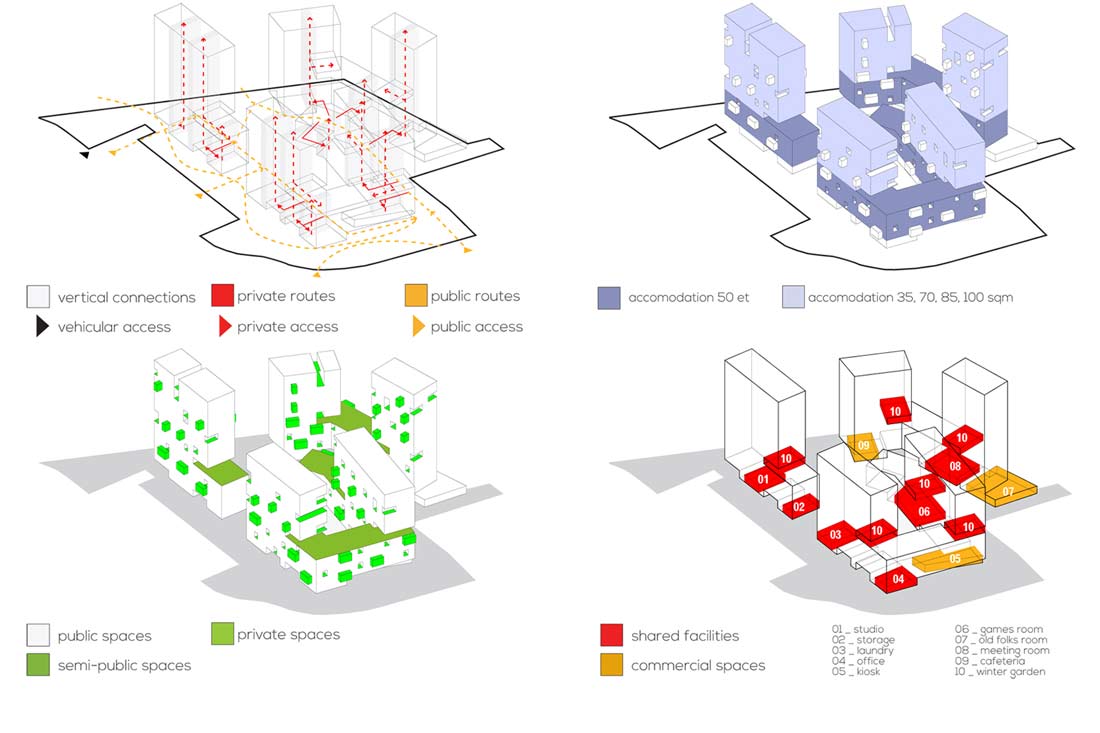



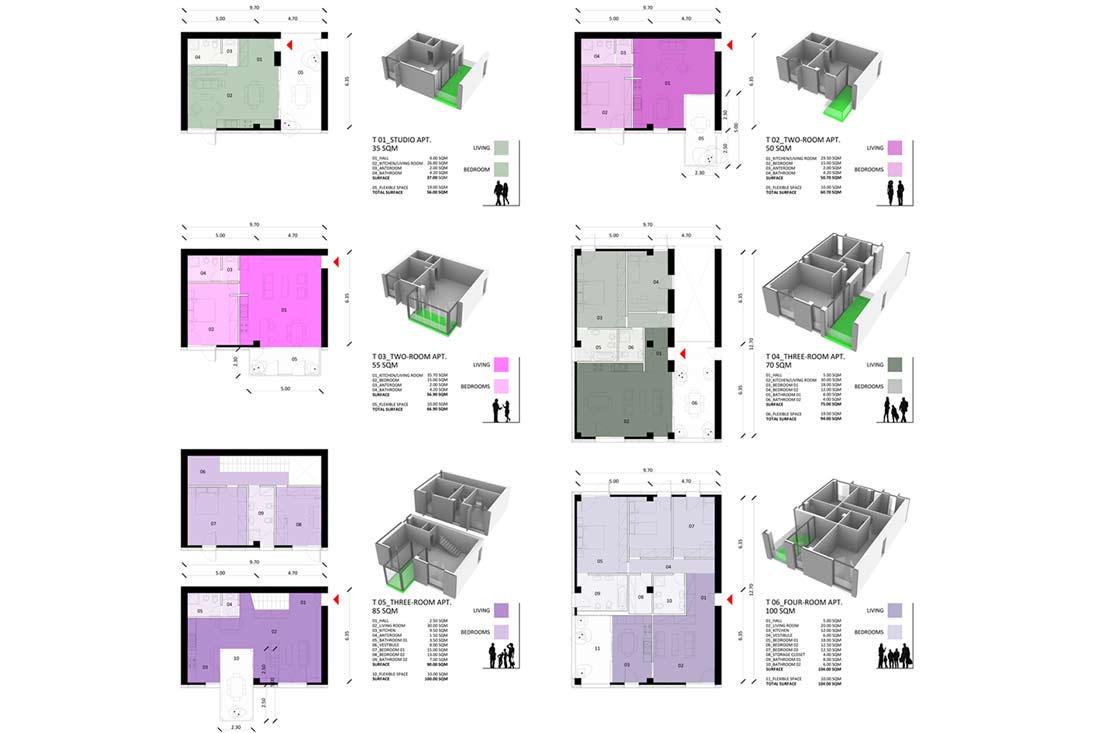



Renewing a company’s internal spaces means treating a urban texture, belonging to the XX century Italian industry, giving it back a new image. The idea is to capture its industrial soul, characterized by sloping roofs, strong functions character defining curves. The new appearance of the canteen represents a different faceting for a certainly gain-orientated company, but conscious of increasing the quality level of the working environment to increase in the employer the sense of belonging, to give back efficiency and loyalty. The environment gets back his distinguishing character, his proportion in a new dimension, in which all young realities and future customers will benefit. The functional layout rises from an internal fluxes study, guiding towards a green-comb solution, parallel developed to the building. Thus, we obtain two results: the view above the green system from the offices (for a better quality of work) and the shadowing above the parking along all building length, without obstructing the heavy-trucks fluxes. The idea of a steel skin, finally, comes from a careful client analysis, to make it last through time with little or no maintenance. Its constructive section has been conceived flexed to better tense the structure, avoiding any vibration caused by wind, and to give a fashionable appearance for a still-growing company.












A house for holidays, in an agricultural context, characterized by a historical cultivations region: the tradition-idea surrounds this house, with dry walls, little stone constructions, terrepleins, olive tree groves, and it becomes a reference value, in a long time anthropic-nature. The project follows an interpretation of the correlation between tradition and contemporary, it recognizes strong building roots and strong changes at the same time, through a house overlapping the ground, free from agricultural requirements. A strong change of perspective, mediated through the preservation of compositive and technical elements, according to traditional conceptions. The building appears to be solid, linked to the ground in his geometric outline, a heavy volume. The elevations show a materic substance in the white plastered walls, recalling an ancient construction idea, with walls as diagonal escarpments. The various dimension squared windows, woodmade, freely dot the elevation on different levels, without freezing in a proportional scheme, concerning to an ancient and non-noble building conformation. Thus, each front is different by others. The wall thickness gushes out from the windows, and once in the internal space, it creates important obliquities on sides, to suggest an orientated and focused vision on the changing landscape and his perspectives, shaded in the horizon with trees, earth, sky. In reality, the walls are made by a mixed system: the lower part, made by concrete blocks, is a stone-full cavity wall; above the concrete architrave, walls become lighter, the section decreases, and the internal and external concrete blocks become one. Internally, the house is characterized by barrel vault roofs, tuff-made, that run parallel to the plan, and define a high-impact image and gravity above the ambients. Materials own a constant reference to local traditions: the vault stones mirrors itself in the leccese stone floor. The plan disposition distinguishes the functional zones, following the best orientation possible, in relation to thermal conditions and landscape views.






















The creative process goes more and more often towards a spatial, distributive and typological compromise of two solutions: a spatial crossbreeding persevering to find a strong image for one building, unique residential complex, moved and composed by several perspectives, enclosing in its soul the duplex lodging logic. The will is to have a unique access, in order to enter a semi-private, protected and south-facing space, with deciduos trees, first filter for an internal stairway to the lodgings, in groups of 5 three-rooms (80 sqm) and 3 four-rooms (105 sqm). The first five have the living area on the ground floor, and the sleeping area on the first floor, while the four-rooms lodgings could be three rooms provided or with a large kitchen. The constructive character defines the will of create a building class A energetically categorized.













Buildings interact through the inhabitants needs and lifestyles: architecture’s aim is to create a possible residential model able to guarantee a new quality of life based upon new contemporary social relationships. A permeable and flexible project, in order to let the new architecture, the city and the park interact, as elements between the urban life and his quality. The structure develops in a two-ways formal register: it interprets the “living scale” considering proportions, and on the other side proposing, at a smaller scale and with more privacy, the new contemporary living. This system reveals itself as a large longitudinal garden, with shining and relaxing spaces, at the green spaces scale (public, semi-public, pedestrian connections, semi-private spaces and private green, south-faced and on +1.00 m level. Qualitative environments are created, like green terraces, allowing users to better perceive the space, with looks on the context and different horizons above the city. With Rizzinelli Vezzoli Architetti














The implied spirit of the project is to create the conditions for the use, the management and the shape of the settlements and the main portions of the four squares, considering that the town is not a gap but an historical presence with its subsequent stratifications, determined by the conformation of the square and the definition of technical, social and expressive aspects. Through visive or material communication means, the project build up a relation-correlation at all levels, creating a social-territorial-spatial continuum, recognizable and praticable. Evaluating the ways could be an engine that, through the decodification of the places, recollects all the squares in one spread and continuous, linked through the road, that represents an oblect to look at.






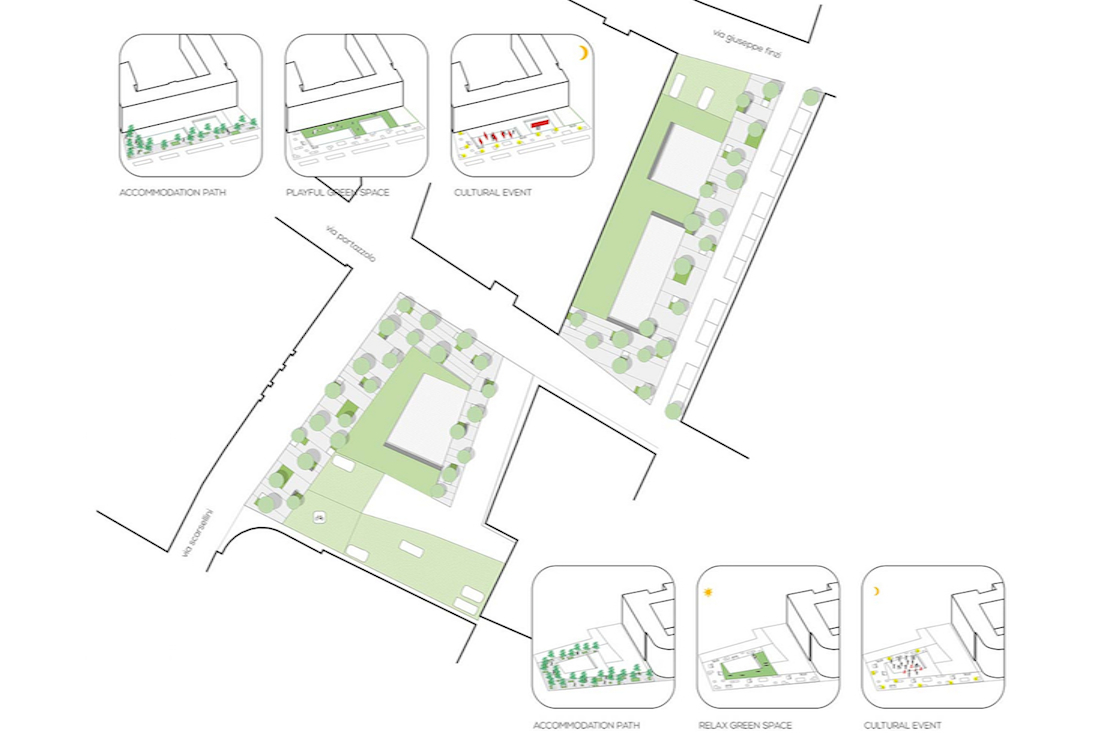





The joining of two lodgings it’s been excuse to divide the living into daily scenes. The house develops on a unique level, but with living and sleeping areas on different levels, linked by a corridor, revealing continuous edges and a frame sequence that amazes the host every time he enters a room. The approach focuses on chromatic and material choices for all those elements appearing in the environments. The tireless research for nature always joins a strongly contemporary act.










Placed in the historical center of Piacenza, the project is conceived as a perpetual expositive way, in which the user can be free to look at a high-quality variety and live a high-seduction space. A scenographic matrix rising from the theatrical frame, to enclose itself in the true emotional soul of continuous exchange, between the desire to be supposed an actor and the reality of being audience. Fiction and reality meet themselves to a place to generate new emotions. With Nicola Falappi















The proposal for the new primary school of Comenduno starts from the guideline of the Project D.P. both to answer the functional requirements and to track a flexible constructive approach and at the same time able to follow the logic by phases not compromising the security of the teaching activity during the construction phase. The project starts with a typical-morphological research. The environment of the City of Albino has a impressive quality of the urban texture and the open spaces; this quality finds remarkable examples of historical architecture, both religious and civic. The project reconnects to these environmental characters finding the instruments for its own definition through the place examples. The new volume, two floors, is a three-volumes free interacting articulation, creating a courtyard open towards south/south-west, looking at the hills on the other side of the valley. The open spaces setting is like a “teaching park”, where different native species can be found: it becomes a botanical heritage both for the new complex and the whole Albino community. Between the two wings of the project the roof of the gym and the permeable wall are green treated. Kids will play in the teaching gardens and technological stuff like photovoltaic trees and windpowered micropiles in the energetic park. This structure will be an interface with the community, revealing energetic results and will increase public spaces in town. With arch. Paolo Mestriner, arch. Anna Donati, arch. Federica Mometto, ing. Giacomo Cavadini, arch. Michela Cibaldi














The project consists on the creation of a new school that breaks each link with the traditional kindergarten as a place of custody, to offer freedom to the student in the environment. The kindergarten is the simple container no more: the project comes from the surroundings and places itself as a edge, a filter between two green principles. The first, directed towards north, starts from the agricultural interpretation, defining a teaching green; the second, directed towards south, rises from the building itself, dilating his hinges, creating winter gardens, meant as spaces for free activities. The project develops starting from a monoblock, with collective use dimensions. For contextual and functional needs, it disjoints itself to create seven recognizable elements and at the same time easily referable to a unique organism. The volumes breaking down defines seven use areas: two host the nursery school, four host the kindergarten and the last host the canteen. The heart of the new building is the free activities spaces part, that becomes the connective space too. The distribution, appearing as a gap, relates itself with the context and becomes the hinge of all functions, so to generate an innovative and homogeneous project.















The area assigned to the new Cultural Multifunctional Center of Samarate is situated in a frayed urban part of the city, alternating to the natural contexts of the Ticino Park. The two principles that develop the project for the Center of Samarate are: to enpower the urban structure in order to link it to the public areas and to conceive an architecture able to relate itself with the adjacent residential context, without renouncing to the civic character. The aim is to measure with the natural context with a building integrated into the park, the easily recognizable, friendly and sharable Park of Culture. The research of a simple architecture, natural for some reasons, integrated in the place and in the collective imaginary, follows those suggestions of a library-economic document, who ask the project reality, concreteness and feasibility. With arch. Paolo Mestriner and eng. Alessandro Gasparini











The project is situated in a place of urban stratification, full of life and town history, in its several facts and events occorre through time. The project develops his meaning starting from a material and pure solid that tries to combine a public building volume that answers to the contextual and functional logic and generates a collective urban space result of movement fluxes. The building defines itself through the relation with the solid volume, not only for the requested functions, but also for the established dialogue between the spaces; the building creates two environments: the empty, nearer to the urban reality, and the solid, cohesive and more useful to the administrative function and his symbolical role. This allows architecture to set itself up and build a dialogue with the context, generating separated fluxes, each concerning one function, his attraction and the suggested relationship. A permeable building is obtained, to be enjoyed from those got sucked in the visceras, seducing through ways and new looks to the lake and to the historical town landmarks. The research of a simple and contextual architecture, innate in the place and in the collective imaginary, follows the suggestions to ask a project to be real, concrete and realizable.















The project aims to give Palermo a unique opportunity of redeem itself and revive, not only for this bare and harsh site, but for the whole city. The project proposes the renaturalization of the environment and the chance to give it to the community. The main idea is to design the houses as residential self-sufficient capsules, by flexible structures assembled in situ. Gem greenhouses are built next to the houses, to allow a self-sustainability, considering that the structure contains deciduous plants: these keep the solar raws during winters, helping the heating system, and their foliage overshadows the house during summers, improving the building thermal comfort. A public wild nature is combined to this private controlled green, in order to create a residential oasis that changes with seasons and settles itself in the context.









The shown project plans the whole realization of the building, that is the planning of internal spaces, kitchen and furniture included.







The concept designed by MFA Architects for Pasha Bank headquarters, in the Baku Port Tower, rises from the will of giving the main base of the bank group a new image, both in Azerbaijan and the world. The starting point was to recognize all the elements that could give Pasha Bank a new identity: recognition, security, style. The bank idea are written in the external characters, giving the facade and the surrounding buildings a strong character of identity. The visible external elements must go through style researches to have an elegant image, so to communicate certainty and trust. The concept of security derives from the “caveau” term: in this situation it recalls an impenetrable monolith and for this reason the use of Travertino marble for floors and walls was so appropriate. The unrelieved use of the stone gives more importance to the daily matters taking place in the bank and the customers take possession of the scene.












The concept for the new Gobustan rupestral museum starts from the context analysis: understanding the meaning, the importance of the place and characters of the environment is the only way to feel the essence of the proposal. The idea of the museum as a discover, as an experience of research and interaction with user: crossing the museum threshold means having the ancient reserve freedom. The suggestion was to create a museum evaluation oasis inside a desert and bare area. Like a precious stone, a track in ground, hollows generate to protect the museum and its area, on which it’s been took green, managed as a green volume, allowing users to walk around, have a rest, admire. These hollows enclose the area, create the museum border and define internal ways, interaction environments (“rocks”), aglaya-covered and easily scratched basements, on which users interprets their ancestors experience in a contemporary way, scratching or drawing his own images, living an attestation of his presence in the museum. The external management is characterized by a teaching area: different ages theme halls and open sky halls, where understanding the country history main elements. These halls, defined “temporal rings”, appear circular shaped and different dimensioned, each characterized not by the temporal enduring of ages, but by the importance of their own discovers and happenings.
With Alessandro Dotti Architect















Lady E rises from the idea to create a theca included in a piece of furniture, with the aim to hide a precious object behind a simple consolle image, enclosing in his inside the make up both as beauty and trick.













The project consists in restoring a portion of an ancient cascina (XVII century), on the Garda Lake riversides, to create a loft able to be used both during winter weekends and summer holidays, independent from the rest of the house, and with a flexible environment for meetings or happenings. The project interprets the context spatial logics, keeping safe the ancient chromatic with contemporary materials: once barn for the manor house, living area for an open space nowadays. The project has fully recovered the attic concerning the disposition, rebuilding the roof. The double height suggested the adopting of plasterboard radiant panels, allowing the heating irradiation, with the lowest temperature change possible. The sculpture-stairway, completely suspended, colonizes the old barn and creates the internal distribution. At least, the home automation system, built within the windows as a technological ring, gives the intervention useful flexibility and contemporary functionality.












The project proposes a new kind of construction, a new principle resuming the country cascinas to make them sustainable farms, made of two different volumes. It concerns an intervention on the Valtenesi country ground, nowadays under oil and olive cultivation. The realization of these two house models is concepted through prefab elements, wood-made and fast to assemble, to at most contextaualize the architecture. The project is definitely sperimental, both in the architectural and technical ways, both for the flexibility and modularity, and for the use of dry construction systems, and all the solutions to favour the energy saving. The project consists in four villas, for a total surface of 800 sqm, with a strongly innovative character for technological solutions and in the social meaning of the term, since it involves landscape and architecture to bring up to live and inhabit.











The aim of the project is the definition of a low-density residential texture characterized by a private open green spaces and public spaces system. The project deals with an aggregation system of residential cells that focuses the characters of an open system, suggesting again the continuity of the urban front and structuring the internal spaces concerning relations and distribution. The aggregation of the residential cells expands itself on the total area of the building land, maintaining penetrability towards the context through a system of accesses and pedestrian ways, getting parking spaces too. The measure system is equal to the house block and tries to interpret the continuity and punctual penetrability system of the local urban settlement. The link and the proportion between solid and empty, as built spaces, public and private spaces, and relation spaces, defines the low-density character.











A new architecture takes action according to the existing architecture in order to build a new complexity. The architectural proposal seeks an expressive relation between the volume of the existing project and the urban and natural landscape, proposing a principle of installation that establish a strong relation with the present and future context. Three purposes typify our new building: the first one is the dialogue between the functions and the existing architecture according to the program; the second one is the volumetric attraction and the expressiveness established between the two buildings and the last one a new look at the nearby environment. The work of these dynamic shell’s forms combine heaven and earth. The “mirror” effect emphasizes the landscape through spatial and changing interrelations. The protections are cleverly treated, as well as the light’s management. This project as set of these elements will remain the symbol of an urban renewal capable of respecting the existing identities and become a significant landmark.






A home that embraces the landscape. The house defines its mode of settlement since the very strong planning constraints but mainly from two foundational elements: the relationship with the ground and the relationship with the landscape. The intention is to create a model of the relationship with the place, which looks like always existed but, at the same time, be an expression of an idea of contemporary domesticity. The house has an irregular plant in C, a kind of open hand that wants to embrace, capturing the relationships with different surrounding geographical horizons, selecting the view of both sides of the living room facing the court and the mountains: the house is configured in this way as a suspended ceiling between the ground and the sky. In the relationship with the ground, the house is placed at the top level of the site, this solution allows to keep the house with a very low volume by exploiting the difference in height to the entrance, where is located a space for the garage and a staircase which connects to the upper level. The use of natural materials such as copper oxidized make the house a highly integrated object with the colors of the landscape. The basement sees the mere presence of a private garage that is connected with an entrance where a internal staircase leads to the upper living area. The access and the external paving are realized with a suspended wood flooring with respect to the ground level in order to make totally permeable the external path. The pedestrian entrance is realized with a slight excavation on the facade. Adjacent to the kitchen, a sliding door separates the sleeping area, which is spread along the corridor towards the glass court: in succession are a single bedroom, a main bathroom, a first double bedroom and the second double bedroom with adjoining private bathroom. Unlike the living area that overlooks the central courtyard, the bedroom opens the view to the outside: in this way, those who use the environments will not have reciprocity problems; same thing for the outside, because the side facing the existing dwelling at 10 meters to the east is totally blind.













This “central” phase of the project follows the same principles of the masterplan. There are some particular topics we would like to explain: The main purpose is to create a high quality life standard. This means living in a city where people feel good, safe, protected: an human scale city. This happens in the old city center with green areas, water, comfort given by natural materials and man-sized spaces. The architectural instruments help us to get this purpose integrating the common elements of two important urban cultures: the italian and chinese one, translating this extraordinary potential in a requirement for the contemporary city. Our aim is to stop the anonymous and ubiquitous international city models like Dubai downtowns. We refuse as well picturesque models that want to recreate past models, far from the reality. We pursue the complexity of the spaces, the strong relationships between infrastructures, and the open and constructed places. We propose an urban nature made of rules that create homogeneity and difference, continuity and variation: this measures the space, it defines a new order without monotony. The urban concept is based on an urban matrix that follows the existing road system and the geographical and topographical references, using the corral as paradigm for the construction of the space. The enclosure gives measure to the space, porosity and continuity, variety, containing different functions with different height buildings, protected from the outside of course, but at the same time connected to it. A basic topic of the project is the integration and separation of the public spaces and their connection to the private sphere. We think that open spaces (courts, squares, malls) should be in relationship each other, defining a real system of open public spaces that allows people living in the streets, with places where children can run free and safe. We think that another fundamental element is to get a high quality life which is called Urban mixitè. Against the functional segregation of the modernist models, we create places where the different functions coexist in the same complex of buildings (commercial, residential, offices, leisure etc..) using and mixing different typologies (courts, towers, blocks). This approach creates real urban life! Very important is the effort to separate car and pedestrian fluxes with the possibility to cross the city without danger. We propose a system of bridges that connect the northern part of the new urban system with the southern one, close to the sea. We designed a path system that allows to move across the city bringing people wherever they want without danger, bybike or by foot, free from cars. This is an essential strategy. Another significant element of the project is that cars are in the streets and the car parkings are under the ground level. Children can run without risk. We build an urban effect: mixing four urban levels, searching complexity and homogeneity like in the historic towns. We have a ground floor called urban level, with public services (school, restaurants) and commercial functions. This is 7.00 meters height. From the 7.00 meters level to 24.5 meters the buildings have residential spaces and from 24.5 meters to 42.5 meters they contain offices. and from 24.5 to 80.0m tower.








The aim of the project is the integration with the context in which it is located, considering as essential the relation with the cornice of the hill and the Maddalena Mountain. The project, therefore, referrers at the natural landscape keeping the visual respect from the street’s hill, thanks to the low height of the outline. The house presents an “L” irregular plan, with a major private aspect on the street side and a more open one on the west side where the hills are. The building volume is characterised by an underground level that is allocated for cars, cellar, laundry and technical room, and by a floor placed above the ground, located at a height of 2,35 m in respect of the medium height of the adjacent street and corresponding to the medium height in which the house is situated that is naturally on an highest elevation from the road. The floor above the ground is define by a living and sleeping area, distributed in the two space’s wings. The living area has a big zone for the living room and for the dining room that is open to the natural cornice and from a liveable kitchen. The building has three bedroom and two restroom, spread on the east side. The volume has a maxim ridge height of 4 meters and a minimum one equal to 2, 75 meters, allowing the view beyond the construction in direction of the hills profile. The house defines a virtual court in which the fourth vertex is constituted by a tree. The disposition in relation with the distance from the boundary valorised the quality of the space opens towards the ridge and it close with the bedrooms to the street. The used materials are three: the glass that is predominant in the lower part, the aluminum that is lay down with the double seam for the building’s covering and it is chromatically integrated with the surroundings by using a dark brown coloration, and the wood: of the windows, of the blind sliding shutters and part of the vertical walls.







On this location the habitat is distinguished by characteristic elements of identity and quality, with the geography of the site and which form the basis of the definition of the project. We propose an architecture that belongs deeply to the place, but which also expresses a differentiation in proposing a real qualification of the environment. Differentiation is distinguished by an optical integration, allowing the materials of the site to become a valuable object, a structure emblematic and seductive being both domestic but also representative of its collective and public function. A suspended architecture and almost immaterial, whose shimmering surface vibrates and changes with the color of the sky. It is a volume distinguishing by a series of dormers different from each other and oriented to the north; Arranged according to a formally dynamic sequence defining the interior space as well as a figurative relationship with the houses and small factories.













Way of living, lifestyle, privacy, sharing, passion, habits, routine.

Learn, exchange, study, passion, knowledge, education, revolution, community.

Sport, entertainment, interaction, socialize, meeting, solidarity, bonding.

Landscape, geography, context, greening, environment, eco-compatibility, sustainability.

Working, productivity, competitiveness, goals, know-how, strategy, co-operation.

Manifestazione di architettura in Novara sul ruolo dell’architetto, Il Ruolo Dell’architetto Tra Processo Creativo, Progetto,Tecnologia (…E Realta’) conferenza di presentazione, organizzato dall’ordine degli architetti di Novara, Italia svoltasi il 13 settembre 2017 a Civica Biblioteca C. Negroni, Novara, Italia




Milano Capitale del Moderno, serie di conferenze organizzate dal Padiglione Architettura in parallelo con l’esposzione universale EXPO Milano 2015, in cui si è presentato il progetto del CTM -Centro Tecnico Municipale a Rixheim, il 15 ottobre 2015 presso il grattacielo Pirelli di Gio Ponti a Milano, Italia



Premio Barbara Cappochin - Edizione 2015, conferenza di presentazione del progetto menzionato CTM -Centro Tecnico Municipale a Rixheim, organizzato dall’ordine degli architetti di Treviso, Italia, svoltasi il 7 dicembre 2015 a Cortina d’Ampezzo,Belluno, Italia


030/MQ, evento promosso da Expo Zoone, organizzato il 24 luglio 2014, finalizzato a far dialogare l’architettura contemporanea nelle sue più svariate forme, presso la Cannoniera di San Marco del Castello a Brescia, Italia


NIB New Italian Blood - TOP10 architettura UNDER36, conferenza per presentare i lavori selezionati al concorso Architettura e Paesaggio 2013, tenutosi il 24 maggio 2013 presso la sala conferenze del Convento di S. Sofia nel centro storico di Salerno, Italia



Learning/Trasforming Slums, organizzato il 14 febbraio 2013 dal Laboratorio di architettura e design urbano - III anno (Prof. Camillo Botticini, Prof. Pierpaolo Danelli), presso Aula Rogers, Campus Leonardo, Politecnico di Milano, Facoltà di Architettura, Milano, Italia


Il senso della materia: l’esperienza sensoriale, tenutosi il 26 settembre 2012, blog con diretta streaming del convegno organizzato da Archievents sulla nuova progettazione incentrata sull’uso della materia, presso Palazzo Grassi a Bologna, Italia


10x10x10 - 10 Architetti 10 Progetti 10 Minuti, tenutosi il 15 marzo 2012 presso lo showroom del marchio di domotica Tecnoliving, incontro atto a favorire l’incontro tra Architetti ed Aziende, al fine di collaborare in modo più costruttivo ed efficiente, Brescia, Italia


Finalista con il progetto del CTM - Centro Tecnico Municipale a Rixheim al concorso Medaglia d’Oro all’Architettura Italiana 2015 promosso da La Triennale di Milano, Milano, Italia




Selezionato con il progetto del CTM - Centro Tecnico Municipale a Rixheim al Premio Giovane Talento dell’Architettura Italiana 2015 - Festa dell’Architetto promosso da CNAPPC, Consiglio Nazionale degli Architetti, Pianificatori, Paesaggisti e Conservatori, Roma, Italia



Progetto selezionato tra i migliori 40 finalisti per il Premio Internazionale Barbara Cappochin - Edizione 2015 con il progetto del CTM - Centro Tecnico Municipale a Rixheim, Cortina d’Ampezzo, Belluno, Italia



Menzione d’onore al Premio Architettura Costruita 2014 - Il Progetto Integrato, promosso da LAC e INARSIND Brescia, con i progetti di intervento di una mensa aziendale e di una pensilina, Ospitaletto, Brescia, Italia


Progetto selezionato al premio NIB New Italian Blood - TOP10 architettura UNDER36, con i progetti del CTM - Centro Tecnico Municipale di Rixheim in Francia, della casa-vacanze nella campagna leccese e il concorso della cantina Bortolin Angelo in Valdobbiadene


Menzione d’onore per l’integrazione tecnologica e del paesaggio con la cultura del luogo al Premio Architettura Costruita 2010, promosso da INARSIND Brescia, con il progetto di una casa vacanze nelle campagne leccesi, Li Fani, Agro di Salve, Lecce, Italia

Est. 2007MFA is an architectural office involved in architecture, urban and landscape design both in private and public sectors.”
Member of the Brescia district architects and landscape designers order since July 2005, professor at L.A.B.A., Academy of Fine Arts in Brescia since 2011 and assistant professor at Politecnico di Milano since 2012. Architect and designer, Matteo Facchinelli was born in Brescia in 1977. In 1999 he has been awarded with a scholarship to attend the Erasmus program in Bruxelles. Thus, he attended his third year of university at the Victor Horta Institute, with Dominique Perrault as visiting professor. He obtained the degree in Architectural Design at the Faculty of Architecture of Politecnico di Milano in 2003, with a final dissertation titled: “A new Hub at Ghedi Montichiari: Airportual Infrastructure”, supervisor: Prof. Arch. Remo Dorigati. From 2003 to 2006, Matteo has been living in Paris, where he had the great opportunity to work at world-famous ateliers, such as Massimilano Fuksas’ and Francis Soler’s. Thanks to these experiences he has gained through the years the capability to manage complex projects, and to date he is able to coordinate and lead teams of architects to bring to completion any architectural project at different scales.
Alberto Peruzzo, Francesco Cicogna, Daniele Quadri, Erica Beluffi, Thomas Wiedmaier, Daniela Privitera, Anna Ghirardi, Martina Pavani, Beibhinn Delaney, Fabio Vavassori, Ilaria Alessandri.
Giacomo Cavadini, Alessandro Gasparini, Augustin Faucheur, Alberto Giovagnoni, Marco Venosta, Moataz Faissail Farid, Aristide Palmisano, Lorenzo Patti, Moreno Marrazzo.
+39 030 83 70 064
